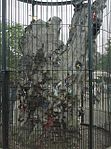War Memorial Shelters
1919 in LondonBuildings and structures completed in 1919Grade II listed buildings in the City of WestminsterGrade II listed monuments and memorialsKensington Gardens ... and 3 more
London building and structure stubsUnited Kingdom listed building stubsWorld War I memorials in England

The War Memorial Shelters are two Grade II listed commemorative shelters in Kensington Gardens, London, about 100m apart, and about 140m east of Kensington Palace, built in about 1919 by the Silver Thimble Fund, to commemorate the Great War, and the soldiers and sailors who fought.The seating inside them was removed in 2013, and they were listed in 2014.
Excerpt from the Wikipedia article War Memorial Shelters (License: CC BY-SA 3.0, Authors, Images).War Memorial Shelters
The Broad Walk, City of Westminster Bayswater
Geographical coordinates (GPS) Address Nearby Places Show on map
Geographical coordinates (GPS)
| Latitude | Longitude |
|---|---|
| N 51.505927 ° | E -0.185755 ° |
Address
Queen Victoria
The Broad Walk
W8 4PX City of Westminster, Bayswater
England, United Kingdom
Open on Google Maps







